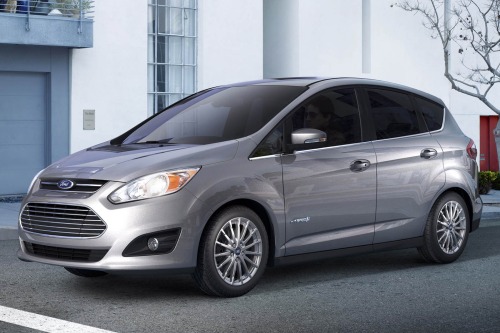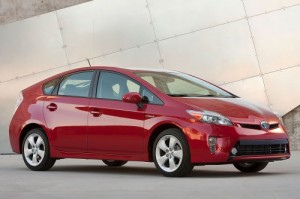One day, back in 2009, while driving my ’99 Chevy Malibu home from classes in Marleboro College’s MBA in Managing for Sustainability, I set a target for my next car that it would get over 45 Miles Per Gallon. That basically means a hybrid like the Ford CMax (Edmunds / Ford) pictured above or one of the uber-efficient Volkswagon TDI Clean Diesel (news / autoblog / VW).
A few weeks ago, when faced with the option of a $1200 repair on said ’99 Chevy – the head gasket – or a replacement car, I decided that it was time to replace the car. The Malibu had 167,000 miles under its serpentine belts (there had been two: the first lasted about 160,000 miles, from August, 1999 until September, 2011. The second would probably be good for another 150,000), it’s tires (three sets), and it’s fuel pumps (two).
Mileage? I got 24 mpg in suburban driving and 30.5 mpg on those trips up to Brattleboro, Vermont. The secret: one stop per 100 or 150 miles, cruise control, speeds between 50 and 68 mph, and a big distance between myself and the car in front of me, so if the driver slowed down I could release the cruise control and slow down gently, minimizing RPMs and maximizing MPGs.
Using the same mindfull driving techniques I got 31-32 mpg in my ’99 Mercury Sable. (That car lasted about 160,000 miles before it was totaled in an accident. It was just as well – while the radio and air conditioner worked to the end; the Sable had no heat – which can be inconvenient in the winter.) Helen and John Taylor, at Fuel Academy, got 84.1 mpg in a stock 2012 Passat TDI SE on a trip from Houston, Texas to Sterling, Virginia.
So now the questions are:
Do I really want a hybrid?
The answer is an unequivocal YES! Every Gallon I don’t burn is less money to the Dictator King of Saudi Arabia, the Dictator President of Venezuela, and the good people at Exxon Mobil, BP Amoco, Chevron Texaco, RD Shell, etc. I drive 12,000 miles per year or more. If I do this in a 25 mpg mid-sized car, I’ll burn 480 gallons. If I drive those same 12,000 miles in a 50 mpg hybrid, I’ll only burn 240 gallons. At $4.00 per gallon, I’ll save $960 per year (and at $5.00 per gallon I’ll save $1,200).
And if so, which one?
In ’09, according to Hybrid Cars . Com, when I made this decision, my options were Toyota Prius, Honda Civic Hybrid, Honda Insight, Chevrolet Malibu,Ford Escape, Ford Fusion,Mercury Milan, Mercury Mariner, Mercedes S-Class, and Lexus HS 250h. BMW also unveiled a hybrid concept. Generally, however, the hybrids were more expensive than the non-hybrid versions, and outside of the 45 mpg Prius, and 40 mpg Civic Hybrid and Insight, all got less than 35 mpg. All were also significantly more expensive than their 20th C gas-only cousins.
We also saw announcements of the Fisker Karma sports car, the VentureOne 100 mpg commuter car, and Phoenix Motorcars’ SUT truck, but the economy was crashing.
And today?
The Toyota Prius (Edmunds / Toyota) still dominates the hybrid space, however, the space is growing.
Ford Motor Company has just released the Cmax Hybrid (Edmunds / Ford) . At the high end, Tesla Motors offers the S and the Roadster. At the low end, Honda still competes with the Insight. Kia offers the Optima Hybrid, Ford offers the Fusion and C Max, Chevrolet offers the Malibu Hybrid, Toyota also offers a Camry Hybrid – the paradigm is shifting.
Chevrolet, Ford and Toyota offer or will offer plug-in hybrids. the Chevy Volt (Chevrolet / Edmunds), Ford C-Max Energi (2013 model due out in in late 2012) and Fusion Energi (2013 model also due out in early 2013), and Toyota Prius Plug In (Toyota / Edmunds) – plug them in at night, run on batteries for 30 to 100 miles, then start burning dead fossilized dinosaurs and ferns. And as an added bonus: If you’re in a blackout, and you have the gear, you can plug your car in and power your house off your car.
The Teslas, like the Nissan Leaf, are all-electric. However, I like the All-American flexibility of a 300 mile driving range, and the middle-class sensibility of a car priced around $25,000 or lower. Thus, I am ruling out the $38,000 Chevy Volt, other $30,000 plug-ins, the $70,000 Tesla S and $100,000 Tesla Roadster and looking long and hard at the $18,500 Honda Insight, the $25,200 C-Max and the $25,000 Toyota Prius V.
While I’m a card-carrying member of the ACLU, I don’t fit the right wing stereotype – In addition to believing in Freedom of Speech, I eat meat, invest in the stock market and drive American cars. Thus I am looking long and hard – and may be negotiating equally long and hard – on the C-Max.
Test Drives:
I test drove a Kia Optima Hybrid, Honda Insight, and Ford C Max. I plan on test driving the Prius, Fusion, and, even tho I probably won’t buy it, the Volt.
The Kia has a very smooth and quiet ride, on it’s nitrogen filled tires. It’s drawbacks are: South Korean manufacture and minimal trunk space. The batteries are in a box at the front of the trunk, up against the back seat. Thus, the back seats don’t fold down, and the trunk space is compromised. This is also the case in the Civic Hybrid.
The Insight is a small car, and rides like one. Road noise is acceptable – meaning loud, and the feel is acceptable – meaning it’s not a smooth ride. Trunk space is good, however, because it’s a hatchback and the rear seats fold down.
The C Max is a big car. Ford calls it a station wagon, but it’s more like a small SUV on a car chassis. It’s quiet, and the ride is smooth.


